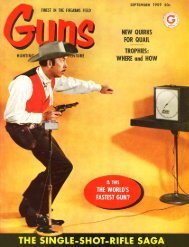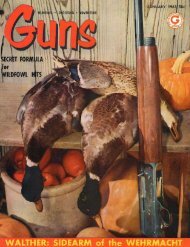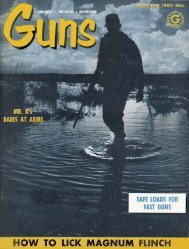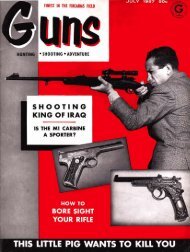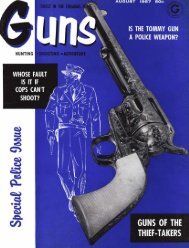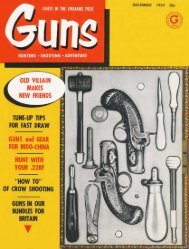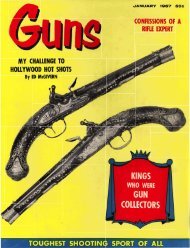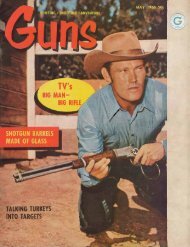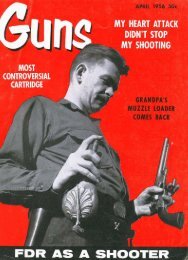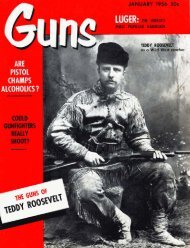You also want an ePaper? Increase the reach of your titles
YUMPU automatically turns print PDFs into web optimized ePapers that Google loves.
standard for the manufacturer long before there was a manufactory;<br />
and, even now, seven generations later, standards established by<br />
custom gunsmiths still persist, more or less, in modern arms<br />
manufacture.<br />
As the concept of machine-made guns with the interchangeable<br />
parts was accepted, plants began springing up throughout Connecticut<br />
like mushrooms after a warm spring rain. Some of the plants<br />
lasted scarcely longer than a mushroom on the plate of a gourmet,<br />
as shooting men spurned guns that were poor in workmanship,<br />
design, or reliability. There were plenty of good gunsmiths around<br />
to provide a man with a gun he could depend on and be proud of.<br />
But the machine-made weapon was gaining in public favor. If the<br />
marriage of wood to metal was slightly less precise in the mass<br />
production gun, the shooter might still accept it if it cost substantially<br />
less than the product of the gunsmith's shop. But workmanship could<br />
not deviate greatly from the uncompromising standards of the gunsmith<br />
or it would find no acceptance at any price.<br />
The manufacturer is keenly aware that he must provide a weapon<br />
which is not only functional but which will be a source of pride to<br />
its owner. The gunsmith's pride in his product still lingers about the<br />
modern gun plant, just as the old time gunmaker looked on himself<br />
as a mechanic apart from other workmen. So do the top executives<br />
and the young sport-shirted lathe operators in gun plants today<br />
consider themselves a breed apart.<br />
66 Its 9 a business for gentlemen," was the way William B. Ruger<br />
summarized his feeling toward the gun industry. With those words,<br />
the head of Sturm-Ruger & Co. paraphrased an intangible feeling,<br />
seldom voiced, that forms a common bond among the mass production<br />
gun makers of Connecticut. By the word "gentleman" Ruger did<br />
not refer to the nolished dilettante with a studied set of manners. He<br />
used the term to denote a type of man possessing the spirit, pride,<br />
taste, and sensibilities of an aristocrat. He classed gun making with<br />
ship building, aircraft manufacture, and other crafts associated with<br />
romance and adventure. This does not mean that Ruger or any other<br />
gun manufacturer in Connecticut has a completely visionary approach<br />
to arms manufacture; there is nothing intrinsically wrong with<br />
making money-and guns must be designed and built with profit in<br />
mind if the manufacturer is to stay in business.<br />
In a young enterprise like Sturm-Ruger, where it is possible to talk<br />
directly with the founder and designer, it is not hard to uncover a<br />
philosophy of gun making. That philosophy is incorporated in the<br />
Centers of gun bugs' interest in Connecticut arms. . - - -<br />
factories range from the newest modern sho s like<br />
Whitney's to older firms such as Marlin's, Moss E erg's,<br />
Colt's, and the small Ruger works headed by one man.





